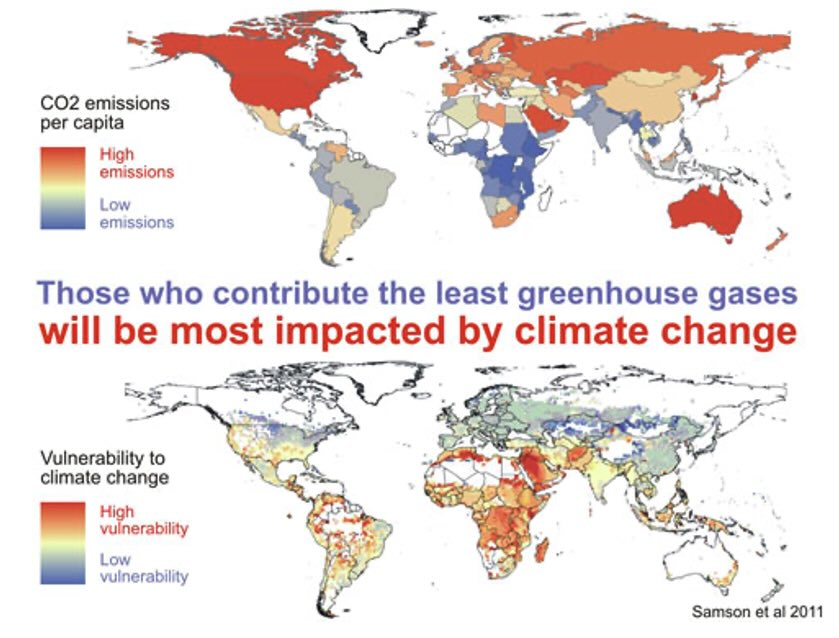The relationship between climate change and security is becoming more conspicuous as the intensity and frequency of climate-related environmental disasters affect fragile countries especially. Climate change increases the likelihood of mass migration and social unrests as result of food insecurity, droughts, heatwaves, and water scarcity. Geopolitical tensions and conflicts can create chaotic political environment and in turn exacerbate the negative impacts of climate change. As a rising technology that is used in natural disaster prediction, medical diagnoses, virtual assistance, navigation tools etc., AI technologies can contribute to the solution climate related problems.
Vulnerable countries to climate change and security problems
International Rescue Committee (IRC) and World Resource Institute (WRI) identified Somalia, Syria, Congo, Afghanistan, Yemen, Chad, South Sudan, Central African Republic, Nigeria, and Ethiopia as the most vulnerable countries to climate-related risks. In 2023, flooding in Somalia affected nearly 100.000 people, thousands of whom had to migrate to other regions. Similarly, Afghanistan has recently suffered a severe drought that has complicated the security problems in the region. Most of these countries have long been suffering from economic and security problems. It means that climate change has the potential to deepen the security problems of countries in the Global South, and these problems can have spillover impacts on other regions.

Figure – 1: Vulnerable countries to climate change (Source: Sceptical Science)
What AI technologies offer
AI technology can reduce the cost of data collection related to impacts of climate change, especially in regions that are hard to reach. For instance, data from the sensors and cameras of UAVs can be analysed to assess the conditions of forests, oceans and glaciers. Based on these analyses, policymakers can make more accurate predictions about the risks of climate migration and food insecurity. The data-processing capacity of machine learning can both detect patterns from collected data and identify societal changes that are difficult to recognise.
Cities are the main contributors to global warming and victims of environmental problems caused by climate change. AI technologies can instantly monitor different parameters such as water consumption, GHG emission concentration, amount of waste, etc., to give relevant information for policymakers to develop effective plans and strategies for climate mitigation and adaptation.
The European Green Deal and AI
EU Emission Trading System and Carbon Border Adjustment Mechanism require massive data flow from installations to calculate the carbon prices. Along the same lines, corporate sustainability regulations (CSRD, CSDDD, EU Taxonomy and SFRD) force companies to disclose information related to their ESG performances. Tracking adverse impacts in global supply chains is also a data-driven process. Integrating renewable energy systems to the power grid and managing the volatile electricity demands necessitate using automated systems. In this regard, AI technologies can be an essential facilitator and accelerator in analysing and managing data (optimisation of renewable energy systems and developing smart grids) to enhance the implementation of EU Green Deal regulations.
Limits of AI technology
AI technologies have some drawbacks that policymakers should pay attention while developing climate mitigation and adaptation plans. First, computing systems can be a significant source of GHG emissions during both their production and use phase. Second, the reliability and accuracy of AI technologies depend on the quality and amount of data used for training these technologies. Information gaps and inaccuracy can lead to erroneous assessment. Third, collection of sufficient data from underrepresented societies can cause ethical problems in the use of AI technologies. Fourth, uncontrolled use of AI technologies may lead the societies to uncharted territories in terms of legal, financial and technical violations. Finally, significant investments in infrastructures are needed, especially in developing countries, for the utilisation of AI effectively.
Conclusion
AI technologies offer significant opportunities to solve complicated and resistant global problems like climate change. As the remaining carbon budget for 1.5 degrees is getting smaller, urgent and compelling actions are needed to slow down GHG emissions. The need to monitor the adverse impacts of climate change, especially in fragile countries, increases the popularity of AI technologies as an effective instrument to help policymakers find proactive solutions.
The European Green Deal can be seen as the new economic paradigm that is required for changing current policies. Other countries should also adopt the philosophy of the EU Green Deal to develop collective and comprehensive actions. Successful implementation of the EU Green Deal regulations can trigger similar policies in other countries. In this context, AI technologies can increase the chance of the EU Green Deal’s success by accelerating the integration of renewable energy systems to smart grids, enabling the tracking of the ESG performances of companies in the value chains and monitoring the needs of vulnerable groups to gain their approval. In parallel, the EU policymakers should find efficient ways to mobilise global financial and technical capabilities to use AI technologies to heal the wounds caused by climate change in fragile countries.

